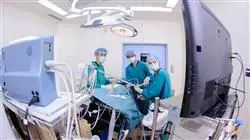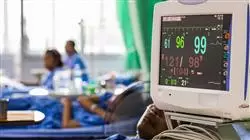University certificate
The world's largest faculty of nursing”
Introduction to the Program
This Advanced master’s degree is an exceptional specialization that will allow you to grow in your profession with the security of having the best content, the most renowned experts in the sector and all the support systems and flexibility you need to achieve the skills of a top professional"

The field of surgical technology is constantly expanding, and hospital managers are increasingly looking to recruit professionals whose profile is adapted to the requirements of their job, and who are qualified and endorsed for carrying out this type of work. This is why a new team awareness has been developed among the professionals in the surgical field. They continue to enrich their professional skills in this field every day, in order to meet the demands of new techniques and care that come with the advances in surgery as a whole.
Each one of the very varied surgical interventions that are performed, requires a specific procedure, a specific technique and the unique surgical material for that intervention. One thing they all have in common is a series of steps and rules that all team members should know in detail. They must also know the general functioning of the surgical department in order to prevent and avoid common risks while carrying out professional work. Bad praxis in this specialist department can cause irreparable damage, and can even be fatal for the patient.
Healthcare institutions are well aware of this and demand academic profiles with a specialization that adapts to the requirements of the job and professionals who are qualified and endorsed to carry out the work.
This ensures that the professional, whether or not they have experience working in any of the departments that make up the perioperative process, integrates into their work practice the experience of professionals already working in nationally and internationally renowned hospitals with a high scientific, technological and humanistic level.
This Advanced master’s degree is a specialization with a greater scientific, technical, teaching and practical scope that provides you with all the necessary knowledge to be at the forefront of this area of intervention. Everything that you need to know, in one place and with all the facilities needed for learning.
Join the forefront of your specialization with this Advanced master’s degree in Operating Room Nursing. An exceptional, high-intensity specialization that will result in a leap towards an extraordinary level of qualification”
This Advanced master’s degree in Operating Room Nursing contains the most complete and up-to-date scientific program on the market. The most important features include:
- Clinical cases presented by experts in the different specialities
- Graphic, schematic and eminently practical contents with the latest scientific and healthcare information
- The latest diagnostic and therapeutic innovations in gynecology and assisted reproduction
- Practical workshops on procedures, diagnosis and treatment techniques
- Real images in high resolution and practical exercises where the self-evaluation process can be carried out to improve learning
- An algorithm-based interactive learning system for decision-making in the clinical situations presented throughout the course
- Theoretical lessons, questions to the expert, debate forums on controversial topics, and individual reflection assignments
- Content that is accessible from any fixed or portable device with an Internet connection
This Advanced master’s degree is the best investment that you could make into your future. A path towards excellence that will help you to become one of the best-trained nurses in the sector. An incredible leap in your competitiveness in the job market”
The teaching staff is made up of the best professionals in the sector. It includes professionals currently working in the field, who bring their experience to this TECH Master’s program, as well as renowned specialists from leading scientific societies.
The multimedia content developed with the latest educational technology will provide the professional with situated and contextual learning, i.e., a simulated environment that will provide immersive training program to train in real situations.
This program is designed around Problem Based Learning, whereby the professional must try to solve the different professional practice situations that arise during the program. For this purpose, the psychologist will be assisted by an innovative interactive video system created by renowned and experienced experts in the field of Operating Room Nursing with extensive teaching experience.

The best teaching quality on the online market, in a state-of-the-art program, created to allow you to truly grow in your profession, from your own computer”
Why study at TECH?
TECH is the world’s largest online university. With an impressive catalog of more than 14,000 university programs available in 11 languages, it is positioned as a leader in employability, with a 99% job placement rate. In addition, it relies on an enormous faculty of more than 6,000 professors of the highest international renown.

Study at the world's largest online university and guarantee your professional success. The future starts at TECH”
The world’s best online university according to FORBES
The prestigious Forbes magazine, specialized in business and finance, has highlighted TECH as “the world's best online university” This is what they have recently stated in an article in their digital edition in which they echo the success story of this institution, “thanks to the academic offer it provides, the selection of its teaching staff, and an innovative learning method aimed at educating the professionals of the future”
A revolutionary study method, a cutting-edge faculty and a practical focus: the key to TECH's success.
The most complete study plans on the university scene
TECH offers the most complete study plans on the university scene, with syllabuses that cover fundamental concepts and, at the same time, the main scientific advances in their specific scientific areas. In addition, these programs are continuously being updated to guarantee students the academic vanguard and the most in-demand professional skills. In this way, the university's qualifications provide its graduates with a significant advantage to propel their careers to success.
TECH offers the most comprehensive and intensive study plans on the current university scene.
A world-class teaching staff
TECH's teaching staff is made up of more than 6,000 professors with the highest international recognition. Professors, researchers and top executives of multinational companies, including Isaiah Covington, performance coach of the Boston Celtics; Magda Romanska, principal investigator at Harvard MetaLAB; Ignacio Wistumba, chairman of the department of translational molecular pathology at MD Anderson Cancer Center; and D.W. Pine, creative director of TIME magazine, among others.
Internationally renowned experts, specialized in different branches of Health, Technology, Communication and Business, form part of the TECH faculty.
A unique learning method
TECH is the first university to use Relearning in all its programs. It is the best online learning methodology, accredited with international teaching quality certifications, provided by prestigious educational agencies. In addition, this disruptive educational model is complemented with the “Case Method”, thereby setting up a unique online teaching strategy. Innovative teaching resources are also implemented, including detailed videos, infographics and interactive summaries.
TECH combines Relearning and the Case Method in all its university programs to guarantee excellent theoretical and practical learning, studying whenever and wherever you want.
The world's largest online university
TECH is the world’s largest online university. We are the largest educational institution, with the best and widest online educational catalog, one hundred percent online and covering the vast majority of areas of knowledge. We offer a large selection of our own degrees and accredited online undergraduate and postgraduate degrees. In total, more than 14,000 university degrees, in eleven different languages, make us the largest educational largest in the world.
TECH has the world's most extensive catalog of academic and official programs, available in more than 11 languages.
Google Premier Partner
The American technology giant has awarded TECH the Google Google Premier Partner badge. This award, which is only available to 3% of the world's companies, highlights the efficient, flexible and tailored experience that this university provides to students. The recognition as a Google Premier Partner not only accredits the maximum rigor, performance and investment in TECH's digital infrastructures, but also places this university as one of the world's leading technology companies.
Google has positioned TECH in the top 3% of the world's most important technology companies by awarding it its Google Premier Partner badge.
The official online university of the NBA
TECH is the official online university of the NBA. Thanks to our agreement with the biggest league in basketball, we offer our students exclusive university programs, as well as a wide variety of educational resources focused on the business of the league and other areas of the sports industry. Each program is made up of a uniquely designed syllabus and features exceptional guest hosts: professionals with a distinguished sports background who will offer their expertise on the most relevant topics.
TECH has been selected by the NBA, the world's top basketball league, as its official online university.
The top-rated university by its students
Students have positioned TECH as the world's top-rated university on the main review websites, with a highest rating of 4.9 out of 5, obtained from more than 1,000 reviews. These results consolidate TECH as the benchmark university institution at an international level, reflecting the excellence and positive impact of its educational model.” reflecting the excellence and positive impact of its educational model.”
TECH is the world’s top-rated university by its students.
Leaders in employability
TECH has managed to become the leading university in employability. 99% of its students obtain jobs in the academic field they have studied, within one year of completing any of the university's programs. A similar number achieve immediate career enhancement. All this thanks to a study methodology that bases its effectiveness on the acquisition of practical skills, which are absolutely necessary for professional development.
99% of TECH graduates find a job within a year of completing their studies.
Advanced Master's Degree in Operating Room Nursing
The procedures performed in an operating room need highly qualified professionals to achieve success in the interventions and ensure the comprehensive care of patients. In the case of nurses, they represent a more than fundamental role, being in charge of the physical and emotional preparation of the individual in each intervention. Are you interested in exploring this healthcare field to add new skills to your career? At TECH, the world's largest online university, you will find a Advanced Master's Degree in Operating Room Nursing, a 100% online program with which you will specialize in managing all the elements that the area demands. Our methodology includes the development of clinical cases that will allow you to reinforce your skills in a practical and dynamic way. In the syllabus, you will find state-of-the-art resources focused on the surgical field, where you will approach the perioperative process related to neurosurgery, general, plastic, thoracic, orthopedic, trauma, cardiac, vascular, gynecological and obstetric surgery. You will learn these and other concepts over the course of two years. From there, you will be able to perform in a rigorous and exhaustive manner, applying the latest diagnostic and therapeutic procedures.
Get qualified in advanced surgical nursing
At TECH we provide you with an unparalleled methodology taught by highly experienced professionals. During this intensive program, you will learn from patient preparation, the perioperative process, the surgical technique of limb amputation and microsurgery in flap and autologous vascular graft interventions, to the architecture of the surgical area and its sterilization to control possible infections. In addition, you will delve into the mechanical suture systems, the application of bandages, the doses of anesthesia to be applied in each procedure, the type of surgical material and the assembly of the specific equipment of the clinical unit. By acquiring this knowledge, you will be able to understand, classify and explain the risks inherent to these interventions, which will be key to manage your practice in a more efficient and productive way. All this, in order to favor the organization and interrelation that the work in the area demands, taking into account the legal and ethical aspects that govern it.







